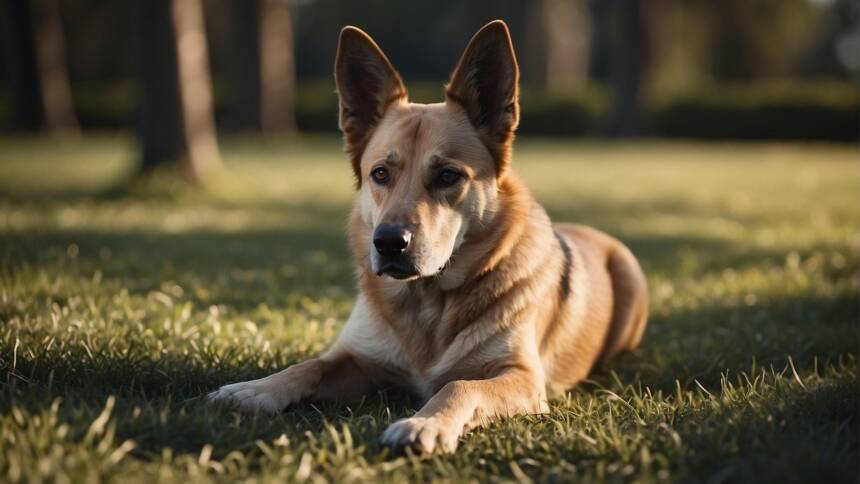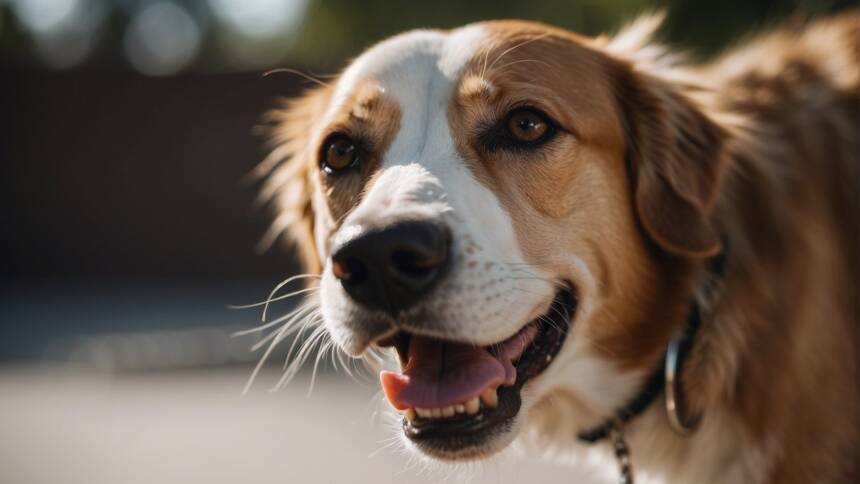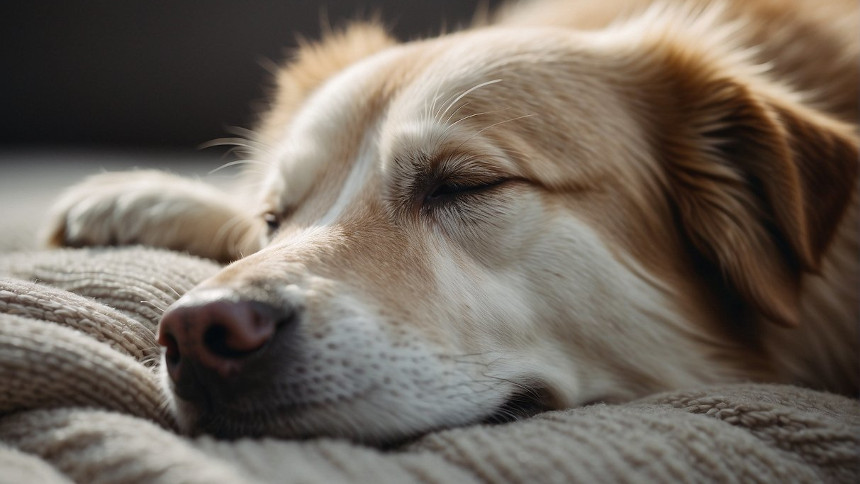When a dog is missing a patch of fur, it can be an indicator of various underlying health issues or environmental factors. This condition can result in a bald spot or several bald spots, which might be accompanied by other symptoms such as skin inflammation, itchiness, or even secondary infections. It’s noteworthy that losing fur isn’t necessarily harmful to a dog as it can be part of a normal shedding process. However, when the hair loss is localized and results in visible bald patches, it’s usually a sign that warrants further investigation.
Parasites like fleas and mites are common culprits behind hair loss in dogs. These pests can cause intense itching, leading a dog to scratch or bite the affected area to the point of hair loss. The irritation caused by parasites can also manifest in redness and skin inflammation. Additionally, a dog’s bald spots could be due to allergies or fungal infections, which may create an environment conducive to the loss of fur.
Beyond external causes, a dog missing a patch of fur may also signal internal health problems. Hormonal imbalances, immune disorders, and systemic conditions such as hypothyroidism or Cushing’s syndrome can lead to dermatological symptoms, including irregular fur loss. Dogs with hormonal issues may also exhibit other changes such as fluctuations in weight, appetite, thirst, and energy levels. As such, observing for additional symptoms is key to diagnosing the root cause of the fur loss.
Identifying the Underlying Causes of Hair Loss
When a dog is missing patches of fur, it’s crucial to identify the root cause, as the underlying issue could range from parasitic infections to hormonal imbalances. Each category of cause can show distinct signs that can help in diagnosing the specific condition.
Hormonal Disorders and Their Effects on the Canine Coat
Hormonal imbalances, such as hypothyroidism or Cushing’s disease, can lead to hair loss in dogs. These conditions affect the normal functioning of hair follicles, often resulting in symmetrical hair loss across the body without skin irritation.
- Hypothyroidism: Can cause hair to become brittle and fall out easily.
- Cushing’s Disease: Often causes hair to thin while the skin becomes thin and fragile.
Parasitic Invasions: Mites and Fleas
Parasites like fleas and mites are common perpetrators of hair loss. These creatures can cause itchiness, leading to excessive scratching and patchy hair loss.
- Fleas: Look for red, inflamed skin, itching, and the presence of flea excrement, which appears as small black dots.
- Demodex Mites: These mites can lead to demodectic mange, which might result in one small area of hair loss or multiple patches. The skin may appear swollen, red, and crusty or show no visible irritation.
Bacterial and Fungal Infections
Bacterial and fungal organisms, such as those causing ringworm, can infect a dog’s skin, leading to patchy hair loss with signs of infection like redness or scaly skin.
- Ringworm: Typically results in circular areas of hair loss with scaly, crusty skin.
- Bacterial Infections: Can cause hair loss, often accompanied by red, inflamed skin and potential discharge.
Allergies and Environmental Factors
Allergies, whether to specific foods, environmental factors, or flea bites, can cause inflammation and hair loss in dogs. Food allergies, for instance, can lead to itchiness and secondary skin infections from excessive scratching.
- Environmental Allergies (Atopy): May result in hair loss around the face and paws.
- Flea Allergies: Typically cause hair loss at the base of the tail and rump area.
Professional Diagnosis and Medical Examination
When a dog presents with a missing patch of fur, it is essential to seek professional veterinary care for a thorough diagnosis and medical examination, as various underlying conditions may be responsible.
The Role of Veterinarians in Canine Dermatology
A veterinarian is central to diagnosing and treating skin conditions in dogs, which could range from parasites to hormonal imbalances. Skin infections, often indicated by itching and inflammation, may be bacterial or fungal. Conditions such as mange, caused by mites, or hypothyroidism are potential culprits for hair loss. A comprehensive physical exam is the first step a veterinarian will take to inspect the affected area and evaluate the dog’s overall health.
Laboratory Tests and Skin Assessments
Following the examination, various laboratory tests may be ordered:
- Blood tests: To check for systemic conditions like hypothyroidism.
- Skin scraping: To detect the presence of mites leading to mange.
- Biopsies: For a deeper analysis of skin tissues when the cause is unclear.
- Smears: To identify bacterial or fungal elements causing infections.
These tests are imperative for an accurate diagnosis, facilitating targeted medication and treatment plans. Proper identification of the underlying condition ensures the dog receives effective care to alleviate symptoms and promote healing.
Treatment Options and Home Remedies
Managing a dog’s missing patch of fur involves multiple approaches including medications, nutritional adjustments, and consistent preventative care to address the root cause and promote hair regrowth.https://www.youtube.com/embed/Mnv6SOP2Gxk
Medications and Topical Solutions
Medications: When a dog is suffering from skin lesions or a fungal infection, antifungal medications are the first line of treatment. Auto-immune disorders and inflammatory conditions may require prescription anti-inflammatories or steroids to reduce swelling and encourage healing.
- Topical Solutions: For irritated or infected skin, vets might prescribe medicated shampoos to alleviate symptoms. If a yeast infection is present, specific antifungal creams or shampoos are used. It’s crucial to follow the vet’s instruction for application frequency to prevent resistance or recurring issues.
Nutritional Adjustments and Supplements
Foods Rich in Omega-3 Fatty Acids: These are known to help improve skin and coat health, potentially alleviating issues like alopecia X and pressure sores by boosting the dog’s metabolism and skin resilience.
- Vitamin E and Supplements: Adding vitamin E to a dog’s diet can improve skin health. Supplements containing melatonin can also aid in cases where hormonal imbalances lead to hair loss.
Preventative Measures and Maintenance
Regular Grooming: Consistently monitor and maintain your dog’s coat to prevent hair loss. Regular grooming helps to identify sores or the onset of conditions that could lead to hair loss.
- Environmental Adjustments: Minimize stressors that could aggravate your dog’s skin. Ensure a clean, stress-free environment and consider hypoallergenic bedding to reduce the risk of pressure sores.
By implementing these treatment options and home remedies, one may improve their dog’s skin health, potentially reducing or eliminating hair loss issues. It is essential to consult with a veterinarian to determine the exact cause of hair loss and receive guidance on the best treatment plan for your dog.
Understanding Canine Behavior and Psychological Impact
Canine bald spots can often be misinterpreted without understanding the interplay between a dog’s emotional state and physical symptoms, such as hair loss (alopecia) and changes in behavior. It’s critical to discern stress indicators and behavioral alterations that may point to the underlying causes of such conditions.
Stress-Induced Hair Loss and Behavioral Signs
When a dog experiences stress, it may manifest in physical symptoms such as shedding or more severe bald spots. This condition, often accompanied by dandruff or a notable increase in scratching and itching, points towards the psychological impact stress has on a dog’s well-being. Alopecia can have a diverse range of triggers, from environmental changes to underlying health issues, but it’s also crucial to recognize the role of psychological factors such as anxiety and stress.
- Pattern of Hair Loss: Unlike normal shedding, which is evenly distributed, stress-induced hair loss often occurs in patches.
- Hot Spots: Areas irritated from excessive licking or scratching may become hot and inflamed, known as “hot spots”.
- Behavioral Changes: Dogs might exhibit anxiety through altered behaviors, like increased aggression or withdrawal.
In the absence of parasites, infections, and hormonal imbalances, a dog’s persistent trauma to the fur through biting, licking, or scratching behaviors can be indicative of emotional distress.
Identifying the signs of stress and mitigating the psychological impact is essential in treating not just the symptoms — such as alopecia — but addressing the root cause of the distress. Regular behavioral assessments, paired with environmental enrichment and professional care, may prevent or diminish the adverse effects of stress on a dog’s physical and emotional health.
Breed-Specific Alopecia and Genetic Predispositions
Certain breeds of dogs are prone to genetic forms of alopecia, which can result in symmetrical hair loss and specific balding patterns. This type of alopecia is often hereditary, showing a clear link between genetics and hair loss in dogs.
Hereditary Patterns and Common Afflictions in Breeds
- Mexican Hairless (Xoloitzcuintli) and Chinese Crested dogs are two breeds where genetic predisposition to hairlessness is standard. Any hair loss in these breeds typically aligns with their natural breed characteristics rather than an underlying condition.
- Dachshunds may experience a form of hereditary alopecia, known as Color Dilution Alopecia, affecting dogs with certain coat colors.
- Greyhounds, among other breeds, might inherit a unique pattern of baldness, often referred to as “Greyhound pattern baldness,” which characteristically is symmetrical and often non-inflammatory.
Patterns of hair loss that are symmetrical can indicate a genetic or endocrine disorder rather than a localized issue, such as demodectic mange, which is more randomized and often associated with mites. Genetics play a crucial role in how alopecia manifests in dogs, creating recognizable patterns and also influencing the likelihood of conditions such as demodectic mange, which can lead to alopecia if not treated adequately. Understanding these patterns enables veterinarians and owners to better assess and manage breed-specific cases of alopecia.
Additional Considerations for Dog Owners
Dog owners must be observant of their pet’s skin health and take preventive measures to mitigate potential issues. Recognizing early signs of skin problems and ensuring regular veterinary care are paramount in preventing and treating conditions such as alopecia, allergies, and parasitic infections.
Monitoring Skin Health and Recognizing Early Signs
Owners should regularly inspect their dog’s coat and skin for any unusual signs. Early detection is crucial in addressing skin conditions effectively. They should look out for:
- Bald spots: Areas where hair is thinning or absent might indicate alopecia.
- Redness or rashes: Skin irritation could be a reaction to allergens such as pollen.
- Itching or scratching: These behaviors often suggest the dog is uncomfortable due to skin issues.
If any of these signs are present, especially if accompanied by symptoms like increased scratching or red skin, further investigation by a veterinarian is advised.
The Importance of Regular Veterinary Checkups
Regular veterinary checkups play a vital role in maintaining a dog’s skin health. Veterinarians can:
- Provide diagnoses for symptoms like hair loss and rashes.
- Advise on treatments which could range from medication to diet changes.
- Perform tests for allergens and parasites like fleas, mites, or lice.
Consistent veterinary care helps catch potential issues early, prevents them from worsening, and offers peace of mind for the dog owner. Regular checkups can keep common problems such as alopecia and reactions to allergens under control, ensuring the dog’s health and comfort.








